流体力学与传热200612A(附参考标准答案)
- 格式:doc
- 大小:165.00 KB
- 文档页数:5
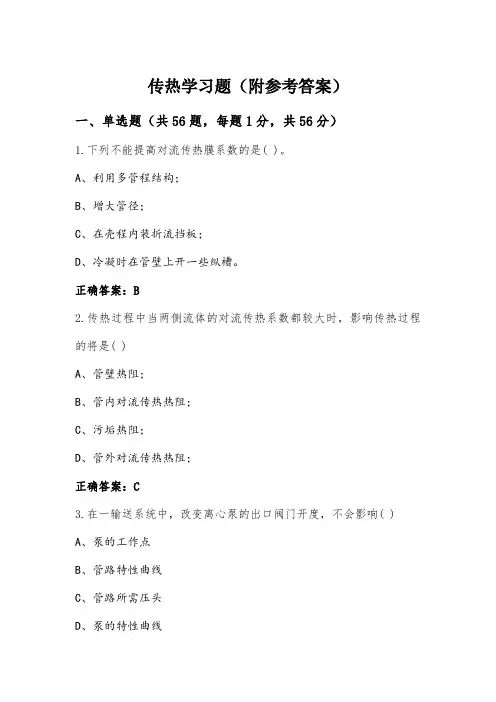
传热学习题(附参考答案)一、单选题(共56题,每题1分,共56分)1.下列不能提高对流传热膜系数的是( )。
A、利用多管程结构;B、增大管径;C、在壳程内装折流挡板;D、冷凝时在管壁上开一些纵槽。
正确答案:B2.传热过程中当两侧流体的对流传热系数都较大时,影响传热过程的将是( )A、管壁热阻;B、管内对流传热热阻;C、污垢热阻;D、管外对流传热热阻;正确答案:C3.在一输送系统中,改变离心泵的出口阀门开度,不会影响( )A、泵的工作点B、管路特性曲线C、管路所需压头D、泵的特性曲线正确答案:D4.用l20℃的饱和蒸汽加热原油,换热后蒸汽冷凝成同温度的冷凝水,此时两流体的平均温度差之间的关系为(Δtm)并流( )(Δtm)逆流A、大于B、小于C、不定D、等于正确答案:D5.橡胶与塑料和纤维比较,正确的是( )。
A、模量最大B、强度最大C、结晶度最大D、Tg最低正确答案:D6.某单程列管式换热器,水走管程呈湍流流动,为满足扩大生产需要,保持水的进口温度不变的条件下,将用水量增大一倍,则水的对流传热膜系数为改变前的( )A、2倍B、1.149倍C、1.74倍D、不变正确答案:C7.按照离心泵完好标准,轻石脑油返输用离心泵机械密封允许泄漏量( )。
A、允许每分钟5滴B、比液化气的允许泄漏量多5滴C、允许每分钟15滴D、允许每分钟10滴正确答案:D8.对于列管式换热器,当壳体与换热管温度差( )时,产生的温度差应力具有破坏性,因此需要进行热补偿A、大于50℃B、大于60℃C、大于45℃D、大于55℃正确答案:A9.下列哪个选项是离心泵的主要部件( )A、电机B、轴封装置和轴向力平衡装置C、密封环D、叶轮和泵壳正确答案:D10.蒸汽中不凝性气体的存在,会使它的对流传热系数α值( )A、升高B、降低C、都可能D、不变正确答案:B11.以乙烯为原料经催化剂催化聚合而得的一种热聚性化合物是( )A、PB、PC、PVCD、PP正确答案:B12.关闭出口阀启动离心泵的原因是( )A、轴功率最大B、能量损失最小C、处于高效区D、启动电流最小正确答案:D13.若被输送液体的黏度增大时,离心泵的效率( )。
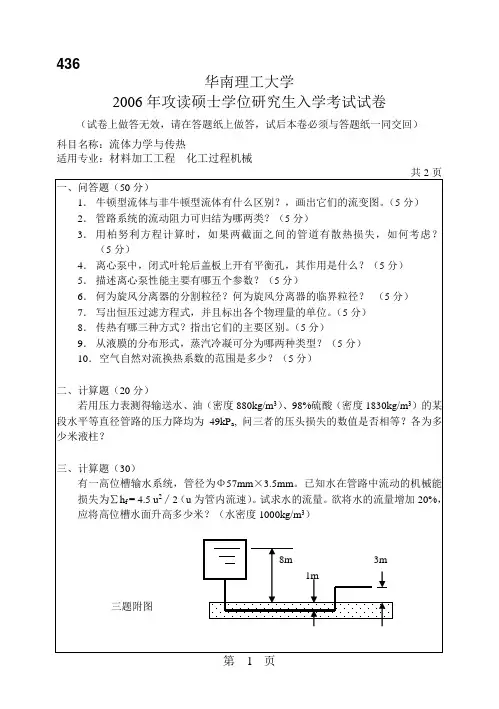
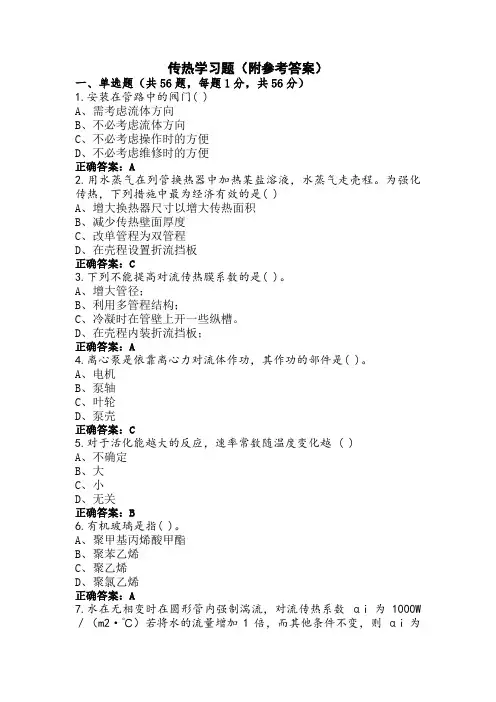
传热学习题(附参考答案)一、单选题(共56题,每题1分,共56分)1.安装在管路中的阀门( )A、需考虑流体方向B、不必考虑流体方向C、不必考虑操作时的方便D、不必考虑维修时的方便正确答案:A2.用水蒸气在列管换热器中加热某盐溶液,水蒸气走壳程。
为强化传热,下列措施中最为经济有效的是( )A、增大换热器尺寸以增大传热面积B、减少传热壁面厚度C、改单管程为双管程D、在壳程设置折流挡板正确答案:C3.下列不能提高对流传热膜系数的是( )。
A、增大管径;B、利用多管程结构;C、冷凝时在管壁上开一些纵槽。
D、在壳程内装折流挡板;正确答案:A4.离心泵是依靠离心力对流体作功,其作功的部件是( )。
A、电机B、泵轴C、叶轮D、泵壳正确答案:C5.对于活化能越大的反应,速率常数随温度变化越 ( )A、不确定B、大C、小D、无关正确答案:B6.有机玻璃是指( )。
A、聚甲基丙烯酸甲酯B、聚苯乙烯C、聚乙烯D、聚氯乙烯正确答案:A7.水在无相变时在圆形管内强制湍流,对流传热系数αi为1000W /(m2·℃)若将水的流量增加1倍,而其他条件不变,则αi为( )A、不变B、500C、2000D、1741正确答案:D8.不属于换热器检修内容的是( )A、清扫管束和壳体B、管束焊口、胀口处理及单管更换C、检查修复管箱、前后盖、大小浮头、接管及其密封面,更换垫片D、检查校验安全附件正确答案:D9.间歇反应器的一个生产周期不包括( )A、出料时间B、反应时间C、加料时间D、设备维修时间正确答案:D10.可在器内设置搅拌器的是( )换热器A、套管B、釜式C、热管D、夹套正确答案:D11.流体流量突然减少,会导致传热温差( )。
A、始终不变B、下降C、升高D、变化无规律正确答案:B12.下列哪个选项不是列管换热器的主要构成部件。
( )A、封头B、管束C、外壳D、蛇管正确答案:D13.列管式换热器一般不采用多壳程结构,而采用( )以强化传热效果A、翅片板B、折流挡板C、隔板D、波纹板正确答案:B14.裂解气深冷分离过程中采用的主要方法是( )A、精馏法B、特殊精馏法C、萃取法D、吸附法正确答案:A15.下面关于裂解气分离流程说法正确的是( )A、一套乙烯装置采用哪种流程,主要取决于流程对所需处理裂解气的适应性、能量消耗、运转周期及稳定性、装置投资等几个方面。
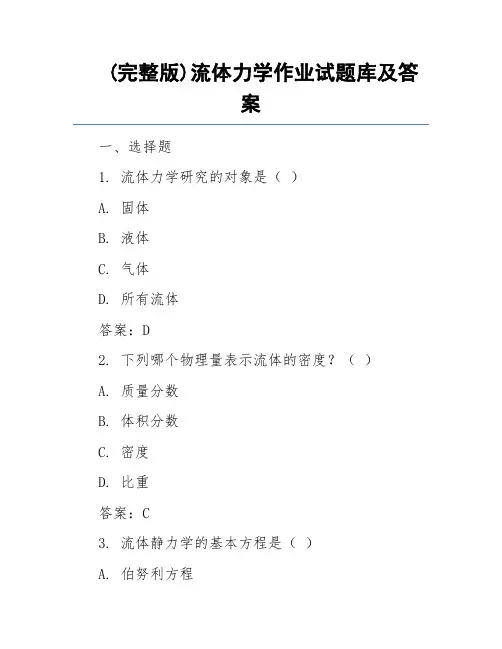
(完整版)流体力学作业试题库及答案一、选择题1. 流体力学研究的对象是()A. 固体B. 液体C. 气体D. 所有流体答案:D2. 下列哪个物理量表示流体的密度?()A. 质量分数B. 体积分数C. 密度D. 比重答案:C3. 流体静力学的基本方程是()A. 伯努利方程B. 连续性方程C. 纳维-斯托克斯方程D. 流体静力学方程答案:D4. 在理想流体中,流速与压强的关系符合()A. 伯努利方程B. 连续性方程C. 纳维-斯托克斯方程D. 流体静力学方程答案:A5. 流体的粘性系数与温度的关系是()A. 正比B. 反比C. 无关D. 随温度升高而减小答案:A二、填空题1. 流体的连续性方程表示流体在运动过程中,______保持不变。
答案:质量2. 流体的粘性系数与流体的______和______有关。
答案:温度、压力3. 在伯努利方程中,流速与压强的关系为:流速越大的位置,______越小。
答案:压强4. 流体力学中的雷诺数是用来判断流体流动的______。
答案:稳定性5. 流体的密度与流体的______和______有关。
答案:温度、压力三、判断题1. 流体力学是研究流体运动和平衡的科学。
()答案:正确2. 理想流体是指粘性系数为零的流体。
()答案:正确3. 流体的粘性系数随温度的升高而减小。
()答案:错误(应为随温度的升高而增大)4. 在伯努利方程中,流速与压强的关系是:流速越大的位置,压强越小。
()答案:正确5. 流体的连续性方程表示流体在运动过程中,质量保持不变。
()答案:正确四、计算题1. 已知一流体的密度为ρ=800 kg/m³,流速为v=10 m/s,求该流体的压强。
答案:根据伯努利方程,流速与压强的关系为:P1 + 0.5ρv₁² = P2 + 0.5ρv₂²。
由于流速v1和v2相等,因此P1 = P2。
所以,该流体的压强为P =0.5ρv² = 0.5 * 800 * 10² = 40000 Pa。
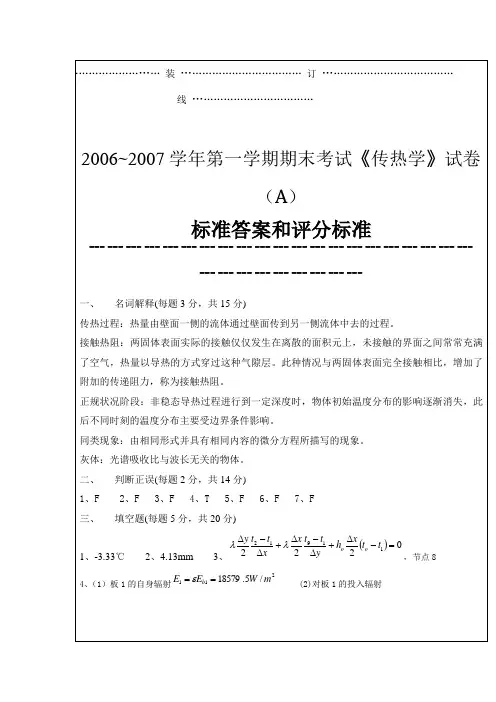
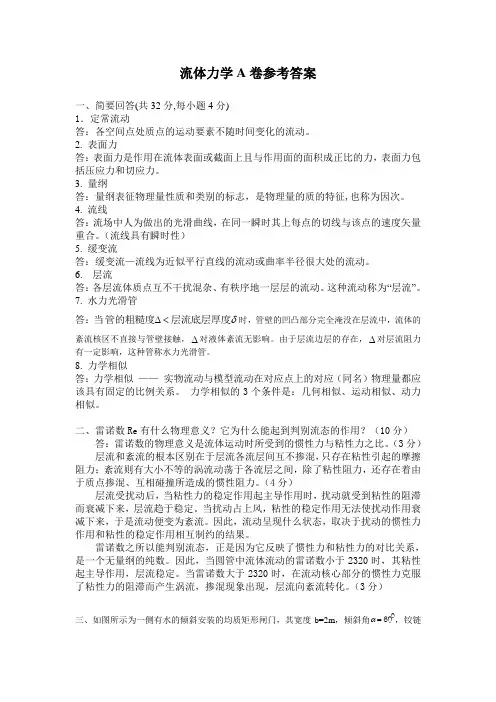
流体力学A卷参考答案一、简要回答(共32分,每小题4分)1.定常流动答:各空间点处质点的运动要素不随时间变化的流动。
2.表面力答:表面力是作用在流体表面或截面上且与作用面的面积成正比的力,表面力包括压应力和切应力。
3. 量纲答:量纲表征物理量性质和类别的标志,是物理量的质的特征,也称为因次。
4. 流线答:流场中人为做出的光滑曲线,在同一瞬时其上每点的切线与该点的速度矢量重合。
(流线具有瞬时性)5. 缓变流答:缓变流—流线为近似平行直线的流动或曲率半径很大处的流动。
6. 层流答:各层流体质点互不干扰混杂、有秩序地一层层的流动。
这种流动称为“层流”。
7. 水力光滑管答:当δ管的粗糙度层流底层厚度时,管壁的凹凸部分完全淹没在层流中,流体的∆<紊流核区不直接与管壁接触,∆对液体紊流无影响。
由于层流边层的存在,∆对层流阻力有一定影响,这种管称水力光滑管。
8. 力学相似答:力学相似——实物流动与模型流动在对应点上的对应(同名)物理量都应该具有固定的比例关系。
力学相似的3个条件是:几何相似、运动相似、动力相似。
二、雷诺数Re有什么物理意义?它为什么能起到判别流态的作用?(10分)答:雷诺数的物理意义是流体运动时所受到的惯性力与粘性力之比。
(3分)层流和紊流的根本区别在于层流各流层间互不掺混,只存在粘性引起的摩擦阻力;紊流则有大小不等的涡流动荡于各流层之间,除了粘性阻力,还存在着由于质点掺混、互相碰撞所造成的惯性阻力。
(4分)层流受扰动后,当粘性力的稳定作用起主导作用时,扰动就受到粘性的阻滞而衰减下来,层流趋于稳定。
当扰动占上风,粘性的稳定作用无法使扰动作用衰减下来,于是流动便变为紊流。
因此,流动呈现什么状态,取决于扰动的惯性力作用和粘性的稳定作用相互制约的结果。
雷诺数之所以能判别流态,正是因为它反映了惯性力和粘性力的对比关系,是一个无量纲的纯数。
因此,当圆管中流体流动的雷诺数小于2320时,其粘性起主导作用,层流稳定。
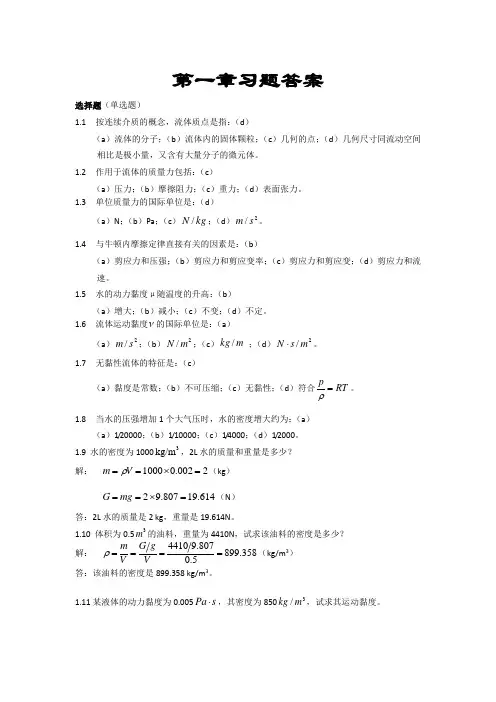
第一章习题答案选择题(单选题)1.1 按连续介质的概念,流体质点是指:(d )(a )流体的分子;(b )流体内的固体颗粒;(c )几何的点;(d )几何尺寸同流动空间相比是极小量,又含有大量分子的微元体。
1.2 作用于流体的质量力包括:(c )(a )压力;(b )摩擦阻力;(c )重力;(d )表面张力。
1.3 单位质量力的国际单位是:(d )(a )N ;(b )Pa ;(c )kg N /;(d )2/s m 。
1.4 与牛顿内摩擦定律直接有关的因素是:(b )(a )剪应力和压强;(b )剪应力和剪应变率;(c )剪应力和剪应变;(d )剪应力和流速。
1.5 水的动力黏度μ随温度的升高:(b )(a )增大;(b )减小;(c )不变;(d )不定。
1.6 流体运动黏度ν的国际单位是:(a )(a )2/s m ;(b )2/m N ;(c )m kg /;(d )2/m s N ⋅。
1.7 无黏性流体的特征是:(c )(a )黏度是常数;(b )不可压缩;(c )无黏性;(d )符合RT p=ρ。
1.8 当水的压强增加1个大气压时,水的密度增大约为:(a )(a )1/20000;(b )1/10000;(c )1/4000;(d )1/2000。
1.9 水的密度为10003kg/m ,2L 水的质量和重量是多少? 解: 10000.0022m V ρ==⨯=(kg )29.80719.614G mg ==⨯=(N )答:2L 水的质量是2 kg ,重量是19.614N 。
1.10 体积为0.53m 的油料,重量为4410N ,试求该油料的密度是多少? 解: 44109.807899.3580.5m G g V V ρ====(kg/m 3) 答:该油料的密度是899.358 kg/m 3。
1.11 某液体的动力黏度为0.005Pa s ⋅,其密度为8503/kg m ,试求其运动黏度。
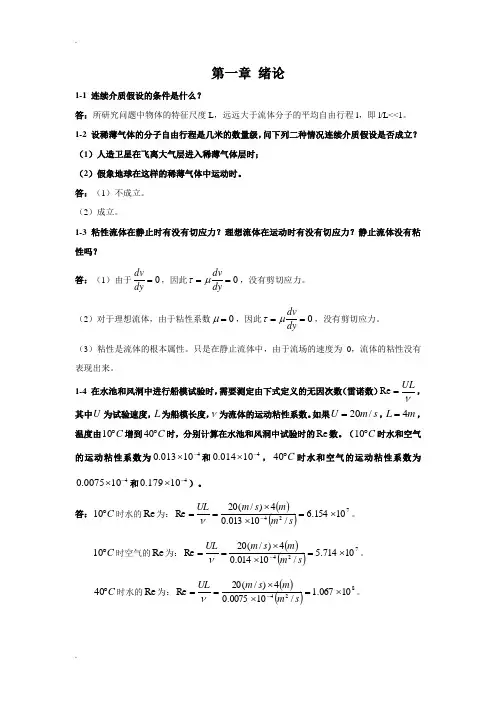
第一章 绪论1-1 连续介质假设的条件是什么?答:所研究问题中物体的特征尺度L ,远远大于流体分子的平均自由行程l ,即l/L<<1。
1-2 设稀薄气体的分子自由行程是几米的数量级,问下列二种情况连续介质假设是否成立? (1)人造卫星在飞离大气层进入稀薄气体层时; (2)假象地球在这样的稀薄气体中运动时。
答:(1)不成立。
(2)成立。
1-3 粘性流体在静止时有没有切应力?理想流体在运动时有没有切应力?静止流体没有粘性吗? 答:(1)由于0=dy dv ,因此0==dydvμτ,没有剪切应力。
(2)对于理想流体,由于粘性系数0=μ,因此0==dydvμτ,没有剪切应力。
(3)粘性是流体的根本属性。
只是在静止流体中,由于流场的速度为0,流体的粘性没有表现出来。
1-4 在水池和风洞中进行船模试验时,需要测定由下式定义的无因次数(雷诺数)νUL=Re ,其中U 为试验速度,L 为船模长度,ν为流体的运动粘性系数。
如果s m U /20=,m L 4=,温度由C ︒10增到C ︒40时,分别计算在水池和风洞中试验时的Re 数。
(C ︒10时水和空气的运动粘性系数为410013.0-⨯和410014.0-⨯,C ︒40时水和空气的运动粘性系数为4100075.0-⨯和410179.0-⨯)。
答:C ︒10时水的Re 为:()()72410154.6/10013.04)/(20Re ⨯=⨯⨯==-sm m s m ULν。
C ︒10时空气的Re 为:()()72410714.5/10014.04)/(20Re ⨯=⨯⨯==-sm m s m ULν。
C ︒40时水的Re 为:()()82410067.1/100075.04)/(20Re ⨯=⨯⨯==-sm m s m ULν。
C ︒40时空气的Re 为:()()62410469.4/10179.04)/(20Re ⨯=⨯⨯==-sm m s m ULν。
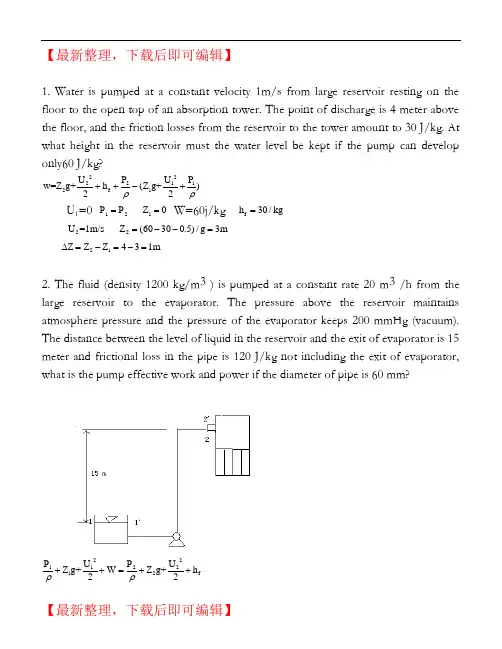
【最新整理,下载后即可编辑】1. Water is pumped at a constant velocity 1m/s from large reservoir resting on the floor to the open top of an absorption tower. The point of discharge is 4 meter above the floor, and the friction losses from the reservoir to the tower amount to 30 J/kg. At what height in the reservoir must the water level be kept if the pump can develop only60 J/kg?2222112f 1U P U P w=Z g+h (Z g+)22ρρ++-+U 1=012P =P10Z =W=60j/kg f h 30/kg = 2U =1m/s 2(60300.5)/g 3m Z =--= 21Z Z Z 431m ∆=-=-=2. The fluid (density 1200 kg/m 3 ) is pumped at a constant rate 20 m 3 /h from the large reservoir to the evaporator. The pressure above the reservoir maintains atmosphere pressure and the pressure of the evaporator keeps 200 mmHg (vacuum). The distance between the level of liquid in the reservoir and the exit of evaporator is 15 meter and frictional loss in the pipe is 120 J/kg not including the exit of evaporator, what is the pump effective work and power if the diameter of pipe is 60 mm?22112212f U UZ g+W Z g+h 22ρρP P ++=++10P =5422200P x1.013x10 2.67x10N /m 760=-=- 31200Kg /m ρ= 1U 0= f h 120J /kg =22V 20U 1.97m /s A 3600*4006===π/*.1Z 0=2Z 15=422.67x101.97W 15x9.81120246.88J /kg 12002=-+++=N W Q 246.88x1200x20/3600=1646W ρ==3. Water comes out of the pipe (Φ108x4 mm), as shown in Fig. The friction loss of the pipeline which does not cover the loss at the exit of pipe can be calculated by the following equation: h f =6.5U 2where U is the velocity in the pipe, find a. water velocity at section A-A'. b. water flow rate, in m 3 /h.22112212f U UZ g+Z g+h 22ρρP P +=++1U 0=12P =P1Z 6m =2Z 0=2f h 6.5U=22U 6x9.81 6.5U 2=+U 2.9m/s = 23V=UA=2.94x01x360082m /h =π/.4. Water passes through the variable pipe. The velocity in the small pipe is 2.5 m/s. The vertical glass tubes are inserted respectively at the section A and B to measure thepressure (see fig.) If the friction loss between two section is 15 J/kg, what is the water column difference between two glass tubes? By the way, draw the relative liquid column height of two tubes in the Fig.a ab b U A U A =2b U 2.5*(33/47)1.23m /s ==22aa b b a b f U U Z g+Z g+h 22ρρP P +=++a b Z =Z22abb a f U U h 22ρρP P -=-+221.23/2 2.5/21512.63=-+= a b P P R g ρ-=∆ 3312.63R=1.29x10m 9.8x10-∆=5. A centrifugal pump takes brine (density 1180 kg/m 3 , viscosity 1.2 cp) from the bottom of a supply tank and delivers it into another tank. The line between the tanks is 300 m of 25 mm diameter pipe (inner diameter). The flow rate is 2 m 3 /h. In this line, there are two gate valves, four elbows (90o ) and one return bend, what is the friction loss if the roughness of pipe is 0.025 mm?22f fst flocalU U h h h 4f k d 22l ∑=+=+∑31180kg /m ρ=300m, d=0.025m l =3-3v 2m /h =1.2cp=1.2x10Pa.s μ=k=0.025mm k/d=0.025/25=0.001c l r k =0.4 k =1 k =2x0.07=0.14 el re k 4x0.75 3 k 1.5-2.2===2u v /A 2/(3600x /4x0.025)1.13m /s π===4u dRe 2.78x10ρμ==f 0.063=2f 2h 4x0.0063x300/0.025x1.13/2+(0.4+1+2x0.07+4x0.7+1.5)x1.13/2 =197.86J/kg∑=6. The orifice meter (diameter of orifice 0.0001 m) is installed for measuring the flow rate. The indicating liquid of orifice is mercury if U shape pressure gauge reading is 0.6 meter and orifice coefficient can be taken as 0.61, what is the flow rate of water?0o o2gR()u c ρρρ-=20o 02gx0.6x(136001000)V u s 0.61x /4x0.0001x1000π-==835.8x10m /s -=7. Water flows through a pipe with a diameter di 100 mm as shown in figure.a. when the valve is closed, R is 600 mm and h equals 1500 mm. While the valve opens partially, R=400 mm and h=1400 mm, f=0.00625 (Finning factor) and k c =0.5 (contraction coefficient), what is the flow rate of water, in m 3 /h?b. If the valve opens fully, what is the pressure of section 2-2', in N/m 2 ? The equivalent length of the valve is 1.5 m and the Fanning factor f keeps the same?(ρH2O =1000kg/m 3, ρHg =13600kg/m 3)(1) the valve opens partially ,for selection 1-1’ and 2-2’ , we have22112212f 1-2u u gZ gZ h 22ρρP P ++=+++2212Hg H o 0 g(R h)39630N/m ρρP =P =-=2212f1-2c u u u 0 Z =0 h 4f +k 2.13ud 22===lWe can get Z1 from the valve closed21Hg H O h=1.5m R=0.6m Z gR/h 6.66m ρρ=-=229.81x6.66u /2 2.13u 39630/1000=++23h u=3.13m/s V 3600x /4x0.1x3.1388.5m /h π==(2) when the valve opens fully, for section 1-1’ and 3-3’, we have 22331113f1-3u u gZ gZ h 22ρρP P ++=+++311Z 0 Z 6.66m u =0==22e f1-3c u 3.1.5h (4f k )(4x0.00625x +0.5) 4.81ud 20.01l l ++=+==229.81x6.66u /2 4.81u =+ u 3.51m/s =For section 1-1’ and 2-2’22112212f1-2u u gZ gZ h 22ρρP P ++=+++112120 Z 6.66 Z 0 u 0 u 3.51P =====22f1-2c l u h (4f k )(4x0.00625x15/0.10.5)3.51/226.2J /kg d 2=+=+=22229.81x6.66 3.15/226.2N 32970m ρP=++P =8. The rotameter is installed to measure the water flow rate, as shown in figure. If the total length including equivalent length of pipeline A is 10 m and the reading of rotameter is 2.72 m 3 /h, what is the flow rate for pipeline B? (f A =0.0075, f B =0.0045)For parallel pipe linefA fB total A B 22A fAA 2A h h V V +V u (l+le) 2.72h 4f 4x0.0075x10/0.053/2()d 23600x /4x0.053π∑=∑=∑∑== 0.333J /kg =22B fB B B B 23B B B B u (l+le)h 4f 4x0.0045x2/0.3/2xu 0.333d 2u 2.36m /s V =u A 2.36x /4x0.23600m /hπ∑∑======10. A flat furnace wall is constructed of 120 mm layer of sil-o-cel brick, with a thermal conductivity 0.08 w/(m o C), backed by a 150 mm of common brick, of conductivity 0.8 w/(m o C), the temperature of inner face of the wall is 1400 o , and that of the outer face is 200o C.a. What is the heat loss through the wall in w per square meter.b. To reduce the heat loss to 600 w/m 2 by adding a layer of cork with k 0.2 w/(m o C) on the outside of common brick, how many meters of cork are requied? a.2Q t 1400200711N /m 11L R 0.080.80.120.15∑∆-===∑+b. 600=(1400-200)/(0.12/0.08+0.15/0.8+x/0.2) x=0.0625m13. Air at the normal pressure passes through the pipe (d i 20 mm) and is heated from 20o C to 100o C. What is the film heat transfer coefficient between the air and pipe wall if the average velocity of air is 10 m/s? The properties of air at 60 o C are as follows:density 1.06 kg/m 3 , viscosity 0.02 cp, conductivity 0.0289 w/(m o C), and heat capacity 1 kJ/kg-K443u d10x0.02x1.06 Re=1.06x10100.02x10ρμ-==> 12T +T 20100T=6022+==℃ 0.141ωμμ⎛⎫= ⎪⎝⎭10000.020.0010.6920.0289p c x x k μ==Pr=()()0.81/3081/34Nu 0027Re Pr0.027x 1.06x10x 0.69239.66==.=.()2i ii h d 39.66 h 39.66x0.0289/0.02=57.22w/m .k k==14. A hot fluid with a mass flow rate 2250 kg/h passes through a ∅25x2.5 mm tube. The physical properties of fluid are as follows:k=0.5 w/(m o C), C p =4 kJ/kg-K, viscosity 10-3 N-s/m 2 , density 1000 kg/m 3 Find:a. Heat transfer film coefficient h i , in w/(m 2 -K).b. If the flow rate decreases to 1125 kg/h and other conditions are the same, what is the h i ?c. If the diameter of tube (inside diameter) decreases to 10 mm, and the velocity u keeps the same as that of case a, calculate h i .d. When the average temperature of fluid and quantity of heat flow per meter of tube are 40 o C and 400 w/m, respectively, what is the average temperature of pipe wall for case a?e. From this problem, in order to increase the heat transfer film coefficient and enhance heat transfer, what kinds of methods can you use and which is better, explain?Hint: for laminar flow, Nu=1.86[Re Pr]1/3for turbulent flow Nu=0.023Re 0.8 Pr 1/3 (1)444N 2250x4u d Gd d 3600x x0.02Re 3.98x10100.001ρππμμμ=====>()()1/30.8081/3424Nu 0023Re Pr 0.023x 3.98x10220.10.5Nuk 220.1x0.5hi 5500w /m k d 0.02⎛⎫== ⎪⎝⎭===.=.(2)12w 2w =4421Re Re /2=2x1010=>0.80.82211Nu Re 0.5Nu Re ⎛⎫== ⎪⎝⎭0.8i2i1h 0.5h = ()0.82i2h 5500x0.53159w /m k ==(3) 44333u d 2000x0.01Re 2x10100.001ρμ===>0.81/3Nu 0.023Re Pr =()2hi=6347w/m k(4)i i w w Q=h A (t-t )=400=500x2x0.02(t-t )πw t=40t 39.41=℃ ℃(5) there methods : increase u or hi or decrease d The first is better15. In a double pipe exchange (Φ23x2 mm), the cold fluid (Cp=1 kJ/kg, flow rate 500 kg/h) passes through the pipe and the hot fluid goes through the outside. The inlet and outlet temperatures of cold fluid are 20 and 80 o , and the inlet and outlet temperatures of hot fluid are 150 and 90o , respectively. The h i (film coefficient inside pipe) is 700 w/(m 2 o C)and overall heat transfer coefficient U o (based on the outside surface of pipe) is 300w/(m 2 o C), respectively. If the heat loss is ignored and the conductivity of pipe wall (steel) is taken as 45 w/(m o C), find: (1) heat transfer film coefficient outside the pipe h o ?(2) the pipe length required for counter flow, in m?(3) what is the pipe length required if the heating medium changes to saturatedvapor(140 o C) and it condenses to saturated liquid and other conditions keep unchanged?(4) When the exchanger is used for a year, it is found that it cannot meet the need of production (the outlet temperature of cold fluid cannot reach 80 o C), explain why? (a)0m o 0i i m d l d 111230.002x23h Vo h d kd 300700x1945x21⎛⎫=-+=-- ⎪⎝⎭ 1/h0=1/U0-(do/hidi+bdo/kdm)=1/300-23/700*19-0.002*23/45*21 ()20h 642.9w/m k =12t +t LMTD=702∆∆℃=Q=UoAo ∆Tm=mcCp(Tcb-Tca)300*2π*0.023*70L=500/3600*1000*(80-20)L=5.4m (c) 8020LMTD=86.514020ln14080-=--℃1122L t 70/86.5L t ∆==∆ 2L 0.81L1 4.4m == (d) scale is formed on the outside ,V 0 is decreased16. Water flows turbulently in the pipe of Φ25x2.5 mm shell tube exchanger. When the velocity of water u is 1 m/s, overall heat transfer coefficient Uo (based on the outer surface area of pipe) is 2115 w/(m 2 o C). If the u becomes 1.5 m/s and other conditions keep unchanged, Uo is 2660 w/( m 2 o C ). What is the film coefficient ho outside the pipe? (Heat resistances of pipe wall and scale are ignored)oi h h Uo 111+= (1)o i o h h U 1'1'1+= (2) (1)-(2)=0.80.80.80.81211111121152660u C u C 1C 1.5C-=-=-C=2859 io h Uo h 111-= ho=8127W/(m2K)17. Water and oil pass parallelly through an exchanger which is 1 m long. The inlet andoutlet temperatures of water are 15 and 40 o C, and those of oil are 150 and 100 o C, respectively. If the outlet temperature of oil decreases to 80 o C, and the flow rates and physical properties and inlet temperatures of water and oil maintain the same, what is the pipe length of new exchanger? (Heat loss and pipe wall resistance are neglected) ()()h h 12c c 21m Q W C T -T W C t t VA t ==-=∆ ()()h h 12c c 21W C T -T 'W C t 't =- 2150100401515080t 15--=-- 2t 50=℃212m1112m2L T T 't 1508092.51.85L T T t 15010069.8-∆-===-∆- 2m1m2L 1.85m L1=1m t 92.5 t 69.8=∆=∆=18. Air which passes through the pipe in turbulent flow is heated from 20 to 80 o C. The saturated vapor at 116.3 o C condenses to saturated water outside the pipe. If air flow rate increases to 120% of the origin and inlet and outlet temperatures of air stay constant, what kind of method can you employ in order to do that? (Heat resistance of pipe wall and scale can be ignored))(111ca cb pc c m i i T T C m T A h -=∆=1Q)'(2212ca cb pc c m i T T C m T A h -=∆=2Q 128.012112i22.12.1h m m c c m i m T T m m T h T ∆∆===∆∆ )803.116/()203.116ln(20801---=∆m T)80/()20ln(20802---=∆h h m T T TTh=118.5oC19. Water flows through the pipe of a Φ25x2.5 mm shell-tube exchanger from 20 to 50 o C. The hot fluid (C p 1.9 kJ/kg o C, flow rate 1.25 kg/s) goes along the shell and the temperatures change from 80 to 30 o C. Film coefficients of water and hot fluid are0.85kw/(m 2 o C) and 1.7 kw/(m 2 o C). What is the overall heat transfer coefficient Uo and heat transfer area if the scale resistance can be ignored? (the conductivity of steel is 45w/(m o C).W=1.25Kg/s Cp=1.9Kj/kg ℃()()2h p 12Q W C T T 1.25x1.9x 80-30119Kw =-==m 3010t 30ln 10-∆= ()200m 00i i m 1V 472w/m k d l d 1h h d kd ++==32i 0m Q 119x10A 13.9m V t 472x18.2===∆20. A spherical particle (density 2650 kg/m 3) settles freely in air at 20 o C (density of air 1.205 kg/m 3 , viscosity 1x10-5 Pa.s). Calculate the maximum diameter of particle if the settle obeys the Stoke s’ Law?Re ≤1 ()2p t p D g U 18D ρρμμρP -== ()23p 18D g μρρρP =-()1/3-10p 18x10D 1.205x9.81x 2650-1.205⎛⎫= ⎪ ⎪⎝⎭=3.85x10-521. A filter press(A=0.1 m 2 ) is used for filtering slurry. The vacuum inside the filter is 500 mm Hg. One liter filtrate can be got after filtering of 5 min and 0.6 more liter filtrate is obtained after 5 more min. How much filtrate will be got after filtering of 5 more min?for filter press 22e V 2VV =KA θ+5 min 22e 12V 0.1x5K +=(1)10min 22e 1.62x1.6V 0.1x10K +=(2)From (1) (2),we can see Ve=0.7 K=4815 min 22V 2x0.7V=48x0.1x15+ V=2.07m 3/h22. The following data are obtained for a filter press (A=0.0093 m 2) in a lab.------------------------------------------------------------------------------------------------pressure difference (kg f /cm 2 ) filtering time (s) filtrate volume (m 3 )1.05 502.27⨯10-3660 9.10⨯10-33.50 17.1 2.27⨯10-3233 9.10⨯10-3Find1) filtering constant K, q e , t e at pressure difference 1.05 kg f /cm 2 ?2) if the frame of filter is filled with the cake at 660 s, what is the end filtering rate (dV/dt)E at P 1.05 kg f /cm 2 ?3) compressible constant of cake s?For p=1.05Kg/cm 22e 2e 2e q 2qq K 0.002270.0002272x q 50K 0.00930.000930.000910.000912x q 660K 0.000930.00093θ+=⎛⎫+= ⎪⎝⎭⎛⎫+= ⎪⎝⎭ We can see K=0.015 qe=0.026For p=3.5Kg/cm 21-s K=2k ∆P 1-s K'=2k '∆P1s K 'K '-∆P ⎛⎫= ⎪∆P ⎝⎭ ()2E e V KA 2V+V d d θ⎛⎫= ⎪⎝⎭23. A slurry is filtered by a 0.1 m 2 filter press at constant pressure if the cake is incompressible. The filter basic equation is as follows:(q+10)2 = 250(t+ 0.4)where q---l/m 2 t----minfind (1) how much filtrate is got after 249.6 min?(2) if the pressure difference is double and the resistance of cake is constant, how much filtrate can be obtained after 249.6 min? (cake is imcompressible)(1)let θ=249.6 ()()2q+10250x 249.60.4=+q=240 V=qA=240*0.1=24 (2) K2k=∆P=∆P K'2k'∆P=∆P K'2K500'2==()()2q'+10500x249.60.4=+q’=343.6 v=34.36。

09流体力学习题1及参考答案一、单项选择题(共15分,每小题1分)1、下列各力中,属于质量力的是( )。
A .离心力B .摩擦力C .压力D .表面力2、下列关于流体粘性的说法中,不准确的说法是( )。
A .粘性是实际流体的固有属性B .构成流体粘性的因素是流体分子间的吸引力C .流体粘性具有传递运动和阻碍运动的双重性D .动力粘度与密度之比称为运动粘度3、在流体研究的欧拉法中,流体质点的加速度由当地加速度和迁移加速度组成,当地加速度反映()。
A .流体的压缩性B .由于流体质点运动改变了空间位置而引起的速度变化率C .流体速度场的不稳定性D .流体速度场的不均匀性4、重力场中流体的平衡微分方程为( )。
A .gdz dp -=B .gdz dp ρ=C .dz dp ρ-=D .gdz dp ρ-=5、无旋流动是指( )的流动。
A .速度环量为零B .迹线是直线C .流线是直线D .速度环量不为零6、压强的量纲[]p 是( )。
A .[]2-MLt B .[]21--t ML C .[]11--t ML D .[]1-MLt7、已知不可压缩流体的流速场为 则流动不属于( )。
A .非均匀流B .非稳定流动C .稳定流动D .三维流动8、动量方程的适用条件是( ) 。
0 ),,(),(⎪⎩⎪⎨⎧===w t z xf z y f u υinout QV QV F )()(ρρ∑-∑=∑A.仅适用于理想流体作定常流动B.仅适用于粘性流体作定常流动C.适用于理想流体与粘性流体作定常或非定常流动D.适用于理想流体与粘性流体作定常流动9、在重力场中作稳定流动的系统,沿流动方向总水头线维持水平的条件是( ) 。
A.管道是水平放置的B.流体为不可压缩流体C.管道是等径管D.流体为不可压缩理想流体10、并联管道系统中,其各支管单位质量流体的能量损失()。
A.不相等B.之和为总能量损失C.相等D.不确定11、边界层的基本特征之一是()。
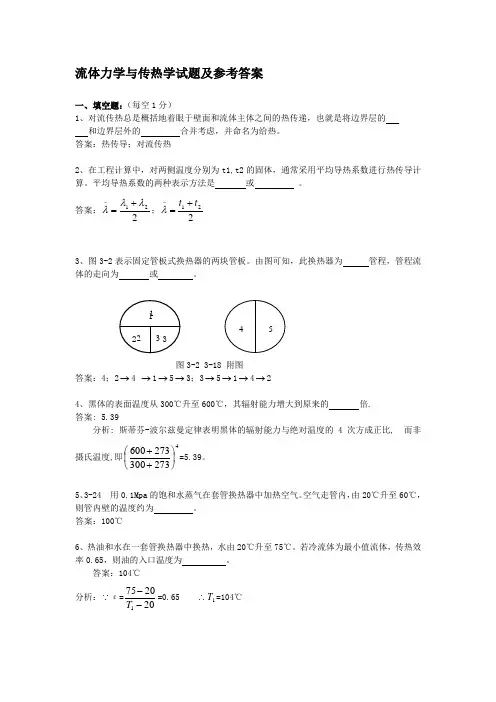
流体力学与传热学试题及参考答案一、填空题:(每空1分)1、对流传热总是概括地着眼于壁面和流体主体之间的热传递,也就是将边界层的 和边界层外的 合并考虑,并命名为给热。
答案:热传导;对流传热2、在工程计算中,对两侧温度分别为t1,t2的固体,通常采用平均导热系数进行热传导计算。
平均导热系数的两种表示方法是 或 。
答案;221λλλ+=-;221t t +=-λ3、图3-2表示固定管板式换热器的两块管板。
由图可知,此换热器为 管程,管程流体的走向为 或 。
1 2 3图3-2 3-18 附图答案:4;2→4 →1→5→3;3→5→1→4→24、黑体的表面温度从300℃升至600℃,其辐射能力增大到原来的 倍. 答案: 5.39分析: 斯蒂芬-波尔兹曼定律表明黑体的辐射能力与绝对温度的4次方成正比, 而非摄氏温度,即4273300273600⎪⎭⎫⎝⎛++=5.39。
5、3-24 用0.1Mpa 的饱和水蒸气在套管换热器中加热空气。
空气走管内,由20℃升至60℃,则管内壁的温度约为 。
答案:100℃6、热油和水在一套管换热器中换热,水由20℃升至75℃。
若冷流体为最小值流体,传热效率0.65,则油的入口温度为 。
答案:104℃ 分析: ε=2020751--T =0.65 ∴1T =104℃1 2 37、因次分析法的基础是 ,又称因次的和谐性。
答案:因次的一致性8、粘度的物理意义是促使流体产生单位速度梯度的_____________。
答案:剪应力9、如果管内流体流量增大1倍以后,仍处于滞流状态,则流动阻力增大到原来的 倍。
答案:210、在滞流区,若总流量不变,规格相同的两根管子串联时的压降为并联时的 倍。
答案:411、流体沿壁面流动时,在边界层内垂直于流动方向上存在着显著的_______________,即使____________很小,____________仍然很大,不容忽视。
答案:速度梯度;粘度;内摩擦应力 12、雷诺数的物理意义实际上就是与阻力有关的两个作用力的比值,即流体流动时的______ 与__ ____ 之比。
(完整word版)流体力学习题及答案-第四章(完整word版)流体力学习题及答案-第四章亲爱的读者:本文内容由我和我的同事精心收集整理后编辑发布到文库,发布之前我们对文中内容进行详细的校对,但难免会有错误的地方,如果有错误的地方请您评论区留言,我们予以纠正,如果本文档对您有帮助,请您下载收藏以便随时调用。
下面是本文详细内容。
最后最您生活愉快~O(∩_∩)O ~第四章流体动力学基本定理及其应用4-1 欧拉运动微分方程和伯努利方程的前提条件是什么,其中每一项代表什么意义?答:(1)欧拉运动微分方程是牛顿第二定律在理想流体中的具体应用,其矢量表达式为:()p f v v t v ?-=??+??ρ1其物理意义为:从左至右,方程每一项分别表示单位质量理想流体的局部惯性力、迁移惯性力、质量力和压力表面力。
(2)伯努利方程的应用前提条件是:理想流体的定常运动,质量力有势,正压流体,沿流线积分。
单位质量理想流体的伯努利方程的表达式为:C gz p=++ρ2V 2,从左至右方程每项分别表示单位质量理想流体的动能、压力能和位能,方程右端常数称流线常数,因此方程表示沿流线流体质点的机械能守恒。
4-2 设进入汽化器的空气体积流量为s m /15.0Q 3=,进气管最狭窄断面直径D=40mm ,喷油嘴直径d=10mm 。
试确定汽化器的真空度。
又若喷油嘴内径d=6mm ,汽油液面距喷油嘴高度为50cm ,试计算喷油量。
汽油的重度3/7355m N =γ。
答:(1)求A 点处空气的速度:设进气管最狭窄处的空气速度为1v ,压力为1p ,则根据流管的连续方程可以得到:()Q v d D =-12241π,因此:()2214dD Qv -=π。
(2)求真空度v p选一条流线,流线上一点在无穷远处F ,一点为A 点;并且:在F 点:0F p p =,0F =v ;在A 点:?1A ==p p ,1A v v =。
将以上述条件代入到伯努利方程中,可以得到:gv p p 20211+=+γγ 因此真空度为:()()222222221101842121d D Q d D Q v p p p v -?=-==-=πρπρρ 若取空气的密度为3/226.1m kg =ρ,那么计算得到:()Pa p v 3222221095.901.004.0114.315.0226.18?=-=。
东南大学2006—2007学年第二学期期末考试《传热学》试题(A 卷)答案一、填空题(每空1分,共20分)1、某物体温度分布的表达式为t=f(x ,y,τ),此温度场为二维(几维)、非稳态(稳态或非稳态)温度场。
2、当等温线图上每两条相邻等温线的温度间隔相同时,等温线的疏密可以直观地反映出不同区域导热热流密度的相对大小。
3、导热微分方程式是根据能量守恒定律和傅里叶定律建立起来的导热物体中的温度场应当满足的数学表达式。
4、工程上常采用肋片来强化传热。
5、换热器传热计算的两种方法是平均温差法和效能-传热单元数法。
6、由于流动起因的不同,对流换热可以区别为强制对流换热与自然对流换热。
7、固体表面附近流体温度发生剧烈变化的薄层称为温度边界层或热边界层,其厚度定义为以过余温度为来流过余温度的99%处。
8、判断两个现象相似的条件是:同名的已定特征数相等;单值性条件相似。
9、凝结有珠状凝结和膜状凝结两种形式,其中珠状凝结有较大的换热强度,工程上常用的是膜状凝结。
10、遵循兰贝特定律的辐射,数值上其辐射力等于定向辐射强度的π倍。
11、单位时间内投射到表面的单位面积上总辐射能为投入辐射,单位时间内离开表面单位面积的总辐射能为该表面的有效辐射,后者包括表面的自身辐射和投入辐射被反射的部分。
二、选择题(每题2分,共16分)1、下列说法不正确的是( D )A 、辐射换热不依赖物体的接触而进行热量传递;B 、辐射换热过程伴随着能量形式的两次转化;C 、一切物体只要其温度T >0K ,都会不断地发射热射线;D 、辐射换热的大小与物体温度差的四次方成正比。
2、大平板采用集总参数法的判别条件是(C )A .Bi>0.1B . Bi=1C . Bi<0.1D . Bi=0.1 3.已知边界周围流体温度和边界面与流体之间的表面传热系数的称为 ( C )A.第一类边界条件B. 第二类边界条件C.第三类边界条件D. 初始条件4、在热辐射分析中,把光谱吸收比与波长无关的物体称为(c ) A 、黑体;B 、透明体;C 、灰体;D 、绝对白体。
……………………………… 装 ……………………………… 订 ………………………………… 线 ………………………………2007~2008学年第二学期期末考试《流体力学与流体机械》Ⅰ试卷(A )标准答案和评分标准﹉﹉﹉﹉﹉﹉﹉﹉﹉﹉﹉﹉﹉﹉﹉﹉﹉﹉﹉﹉﹉﹉﹉﹉﹉﹉﹉﹉﹉﹉一、是非判断题:(对者打“√”,错者打“×”,每小题2.5分,计30分)1.在一定剪切力作用下,能够变形的物质都叫做流体。
×2.流体之所以作为连续介质假设,是因为我们所研究的对象是由大量分子组成的宏观流体的机械运动。
√3.流体的体积压缩系数βP 是一个有因次的物理量,其单位与流体压强的单位相反。
√4.有势质量力的势函数与流体压强之间的关系可以写成 C pU +=ρ。
√5.冷、热流体的相对压力沿高度方向的变化规律是不同的,位置越高的地方,冷气体的相对压力越大。
×6.在稳定流场中,流体的当地加速度为零;在均匀流场中,流体的迁移加速度为零。
√7.由速度分布式 k j x i y u 22935ττ-+=可知,该速度场为三维的不稳定速度场。
×8.若流场中流体质点的流线与迹线均为圆周线,那么该流场一定是有旋流场。
×9.在不可压缩三维无旋流场中,流函数与速度势函数同时满足拉普拉斯方程。
×10.对于稳定的缓变流来说,在流道的某一过流截面上,各点的)(z g p+ρ都相等。
√11.由A u Q =可知,通过圆管内层流流动的流体,其体积流量与管径的平方成正比。
×12.在紊流附面层的层流底层区内,由于流体是分层流动的,所以该区域定为无旋流动。
×二、解答题:(每小题6分,计36分)1、在一直径为200 mm 的圆筒内置一同心小圆筒,两筒之间的间隙为1.0 mm ,其间充满动力粘度为0.52 Pa ·s 的油液,相对移动速度为0.5 m/s ,问每米长圆筒所受的摩擦力是多少?已知:d =200 mm ,δ=1.0 mm ,μ=0.52 Pa ·s ,u =0.5 m/s 。
1. Water is pumped at a constant velocity 1m/s from large reservoir resting on the floor to the open top of an absorption tower. The point of discharge is 4 meter above the floor, and the friction losses from the reservoir to the tower amount to 30 J/kg. At what height in the reservoir must the water level be kept if the pump can develop only60 J/kg?2222112f 1U P U P w=Z g+h (Z g+)22ρρ++-+ U 1=0 12P =P 10Z = W=60j/kg f h 30/kg =2U =1m/s 2(60300.5)/g 3m Z =--=21Z Z Z 431m ∆=-=-=2. The fluid (density 1200 kg/m 3 ) is pumped at a constant rate 20 m 3 /h from the large reservoir to the evaporator. The pressure above the reservoir maintains atmosphere pressure and the pressure of the evaporator keeps 200 mmHg (vacuum). The distance between the level of liquid in the reservoir and the exit of evaporator is 15 meter and frictional loss in the pipe is 120 J/kg not including the exit of evaporator, what is the pump effective work and power if the diameter of pipe is 60 mm?22112212f U U Z g+W Z g+h 22ρρP P ++=++ 10P = 5422200P x1.013x10 2.67x10N /m 760=-=- 31200Kg /m ρ= 1U 0= f h 120J /kg =22V 20U 1.97m /s A 3600*4006===π/*. 1Z 0= 2Z 15= 422.67x101.97W 15x9.81120246.88J /kg 12002=-+++= N W Q 246.88x1200x20/3600=1646W ρ==3. Water comes out of the pipe (Φ108x4 mm), as shown in Fig. The friction loss of the pipeline which does not cover the loss at the exit of pipe can be calculated by the following equation:h f =6.5U 2where U is the velocity in the pipe, finda. water velocity at section A-A'.b. water flow rate, in m 3 /h. 22112212f U U Z g+Z g+h 22ρρP P +=++ 1U 0= 12P =P 1Z 6m = 2Z 0=2f h 6.5U = 22U 6x9.81 6.5U 2=+ U 2.9m/s = 23V=UA=2.94x01x360082m /h =π/.4. Water passes through the variable pipe. The velocity in the small pipe is 2.5 m/s. The vertical glass tubes are inserted respectively at the section A and B to measure the pressure (see fig.) If the friction loss between two section is 15 J/kg, what is the water column difference between two glass tubes? By the way, draw the relative liquid column height of two tubes in the Fig.a ab b U A U A = 2b U 2.5*(33/47)1.23m /s == 22a a b b a b f U U Z g+Z g+h 22ρρP P +=++ a b Z =Z 22a b b a f U U h 22ρρP P -=-+221.23/2 2.5/21512.63=-+= a b P P R g ρ-=∆ 3312.63R=1.29x10m 9.8x10-∆=5. A centrifugal pump takes brine (density 1180 kg/m 3 , viscosity 1.2 cp) from the bottom of a supply tankand delivers it into another tank. The line between the tanks is 300 m of 25 mm diameter pipe (inner diameter). The flow rate is 2 m 3 /h. In this line, there are two gate valves, four elbows (90o ) and one return bend, what is the friction loss if the roughness of pipe is 0.025 mm?22f fst flocal U U h h h 4f k d 22l ∑=+=+∑ 31180kg /m ρ= 300m, d=0.025m l =3-3v 2m /h =1.2cp=1.2x10Pa.s μ=k=0.025mm k/d=0.025/25=0.001c l r k =0.4 k =1 k =2x0.07=0.14el re k 4x0.75 3 k 1.5-2.2===2u v /A 2/(3600x /4x0.025)1.13m /s π===4u d Re 2.78x10ρμ== f 0.063= 2f 2h 4x0.0063x300/0.025x1.13/2+(0.4+1+2x0.07+4x0.7+1.5)x1.13/2 =197.86J/kg∑=6. The orifice meter (diameter of orifice 0.0001 m) is installed for measuring the flow rate. The indicating liquid of orifice is mercury if U shape pressure gauge reading is 0.6 meter and orifice coefficient can be takenas 0.61, what is the flow rate of water?o u c =20o 0V u s 0.61x /4x0.0001π==835.8x10m /s -=7. Water flows through a pipe with a diameter di 100 mm as shown in figure.a. when the valve is closed, R is 600 mm and h equals 1500 mm. While the valve opens partially, R=400 mm and h=1400 mm, f=0.00625 (Finning factor) and k c =0.5 (contraction coefficient), what is the flow rate of water, in m 3 /h?b. If the valve opens fully, what is the pressure of section 2-2', in N/m 2 ? The equivalent length of the valve is1.5 m and the Fanning factor f keeps the same?(ρH2O =1000kg/m 3, ρHg =13600kg/m 3)(1) the valve opens partially ,for selection 1-1’ and 2-2’ , we have 22112212f 1-2u u gZ gZ h 22ρρP P ++=+++ 2212Hg H o 0 g(R h)39630N/m ρρP =P =-= 2212f1-2c u u u 0 Z =0 h 4f +k 2.13u d 22===l We can get Z1 from the valve closed21Hg H O h=1.5m R=0.6m Z gR/h 6.66m ρρ=-=229.81x6.66u /2 2.13u 39630/1000=++23h u=3.13m/s V 3600x /4x0.1x3.1388.5m /h π==(2) when the valve opens fully, for section 1-1’ and 3-3’, we have 22331113f1-3u u gZ gZ h 22ρρP P ++=+++ 311Z 0 Z 6.66m u =0== 22e f1-3c u 3.1.5h (4f k )(4x0.00625x +0.5) 4.81u d 20.01l l ++=+== 229.81x6.66u /2 4.81u =+ u 3.51m/s =For section 1-1’ and 2-2’22112212f1-2u u gZ gZ h 22ρρP P ++=+++ 112120 Z 6.66 Z 0 u 0 u 3.51P ===== 22f1-2c l u h (4f k )(4x0.00625x15/0.10.5)3.51/226.2J /kg d 2=+=+= 22229.81x6.66 3.15/226.2N 32970mρP =++P =8. The rotameter is installed to measure the water flow rate, as shown in figure. If the total length including equivalent length of pipeline A is 10 m and the reading of rotameter is 2.72 m 3 /h, what is the flow rate for pipeline B? (f A =0.0075, f B =0.0045)For parallel pipe line fA fB total A B22A fA A 2A h h V V +V u (l+le) 2.72h 4f 4x0.0075x10/0.053/2()d 23600x /4x0.053π∑=∑=∑∑== 0.333J /kg = 22B fB B B B 23B B B B u (l+le)h 4f 4x0.0045x2/0.3/2xu 0.333d 2u 2.36m /s V =u A 2.36x /4x0.23600m /h π∑∑======10. A flat furnace wall is constructed of 120 mm layer of sil-o-cel brick, with a thermal conductivity 0.08 w/(m o C), backed by a 150 mm of common brick, of conductivity 0.8 w/(m o C), the temperature of inner face of the wall is 1400 o , and that of the outer face is 200o C.a. What is the heat loss through the wall in w per square meter.b. To reduce the heat loss to 600 w/m 2 by adding a layer of cork with k 0.2 w/(m o C) on the outside of common brick, how many meters of cork are requied? a. 2Q t 1400200711N /m 11L R 0.080.80.120.15∑∆-===∑+ b. 600=(1400-200)/(0.12/0.08+0.15/0.8+x/0.2)x=0.0625m13. Air at the normal pressure passes through the pipe (d i 20 mm) and is heated from 20o C to 100o C. What is the film heat transfer coefficient between the air and pipe wall if the average velocity of air is 10 m/s? The properties of air at 60 o C are as follows:density 1.06 kg/m 3 , viscosity 0.02 cp, conductivity 0.0289 w/(m o C), and heat capacity 1 kJ/kg-K443u d 10x0.02x1.06 Re=1.06x10100.02x10ρμ-==>12T +T 20100T=6022+==℃ 0.141ωμμ⎛⎫= ⎪⎝⎭10000.020.0010.6920.0289p c x x k μ==Pr= ()()0.81/3081/34Nu 0027Re Pr 0.027x 1.06x10x 0.69239.66==.=. ()2i i i h d 39.66 h 39.66x0.0289/0.02=57.22w/m .k k ==14. A hot fluid with a mass flow rate 2250 kg/h passes through a ∅25x2.5 mm tube. The physical properties of fluid are as follows:k=0.5 w/(m o C), C p =4 kJ/kg-K, viscosity 10-3 N-s/m 2 , density 1000 kg/m 3 Find:a. Heat transfer film coefficient h i , in w/(m 2 -K).b. If the flow rate decreases to 1125 kg/h and other conditions are the same, what is the h i ?c. If the diameter of tube (inside diameter) decreases to 10 mm, and the velocity u keeps the same as that of case a, calculate h i .d. When the average temperature of fluid and quantity of heat flow per meter of tube are 40 o C and 400 w/m, respectively, what is the average temperature of pipe wall for case a?e. From this problem, in order to increase the heat transfer film coefficient and enhance heat transfer, what kinds of methods can you use and which is better, explain?Hint: for laminar flow, Nu=1.86[Re Pr]1/3for turbulent flow Nu=0.023Re 0.8 Pr 1/3 (1) 444N 2250x4u d Gd d 3600x x0.02Re 3.98x10100.001ρππμμμ=====> ()()1/30.8081/3424Nu 0023Re Pr 0.023x 3.98x10220.10.5Nuk 220.1x0.5hi 5500w /m k d 0.02⎛⎫== ⎪⎝⎭===.=. (2) 12w 2w = 4421Re Re /2=2x1010=> 0.80.82211Nu Re 0.5Nu Re ⎛⎫== ⎪⎝⎭ 0.8i2i1h 0.5h = ()0.82i2h 5500x0.53159w /m k == (3) 44333u d 2000x0.01Re 2x10100.001ρμ===> 0.81/3Nu 0.023Re Pr = ()2hi=6347w/m k(4)i i w w Q=h A (t-t )=400=500x2x0.02(t-t )πw t=40t 39.41=℃ ℃(5) there methods : increase u or hi or decrease dThe first is better15. In a double pipe exchange (Φ23x2 mm), the cold fluid (Cp=1 kJ/kg, flow rate 500 kg/h) passes throughthe pipe and the hot fluid goes through the outside. The inlet and outlet temperatures of cold fluid are 20 and 80 o , and the inlet and outlet temperatures of hot fluid are 150 and 90o , respectively. The h i (film coefficient inside pipe) is 700 w/(m 2 o C)and overall heat transfer coefficient U o (based on the outside surface of pipe) is 300w/(m 2 o C), respectively. If the heat loss is ignored and the conductivity of pipe wall (steel) is taken as 45 w/(m o C), find:(1) heat transfer film coefficient outside the pipe h o ?(2) the pipe length required for counter flow, in m?(3) what is the pipe length required if the heating medium changes to saturated vapor(140 o C) and it condenses to saturated liquid and other conditions keep unchanged?(4) When the exchanger is used for a year, it is found that it cannot meet the need of production (the outlet temperature of cold fluid cannot reach 80 o C), explain why? (a) 0m o 0i i m d l d 111230.002x23h Vo h d kd 300700x1945x21⎛⎫=-+=-- ⎪⎝⎭ 1/h0=1/U0-(do/hidi+bdo/kdm)=1/300-23/700*19-0.002*23/45*21()20h 642.9w/m k =12t +t LMTD=702∆∆℃= Q=UoAo ∆Tm=mcCp(Tcb-Tca) 300*2π*0.023*70L=500/3600*1000*(80-20)L=5.4m(c) 8020LMTD=86.514020ln 14080-=--℃ 1122L t 70/86.5L t ∆==∆ 2L 0.81L1 4.4m == (d) scale is formed on the outside ,V 0 is decreased16. Water flows turbulently in the pipe of Φ25x2.5 mm shell tube exchanger. When the velocity of water u is 1 m/s, overall heat transfer coefficient Uo (based on the outer surface area of pipe) is 2115 w/(m 2 o C). If the u becomes 1.5 m/s and other conditions keep unchanged, Uo is 2660 w/( m 2 o C ). What is the film coefficient ho outside the pipe? (Heat resistances of pipe wall and scale are ignored)o i h h Uo 111+= (1) oi o h h U 1'1'1+= (2) (1)-(2)= 0.80.80.80.81211111121152660u C u C 1C 1.5C-=-=- C=2859 io h Uo h 111-= ho=8127W/(m2K)17. Water and oil pass parallelly through an exchanger which is 1 m long. The inlet and outlet temperatures of water are 15 and 40 o C, and those of oil are 150 and 100 o C, respectively. If the outlet temperature of oil decreases to 80 o C, and the flow rates and physical properties and inlet temperatures of water and oil maintain the same, what is the pipe length of new exchanger? (Heat loss and pipe wall resistance are neglected) ()()h h 12c c 21m Q W C T -T W C t t VA t ==-=∆()()h h 12c c 21W C T -T 'W C t 't =-2150100401515080t 15--=-- 2t 50=℃ 212m1112m2L T T 't 1508092.51.85L T T t 15010069.8-∆-===-∆- 2m1m2L 1.85m L1=1m t 92.5 t 69.8=∆=∆=18. Air which passes through the pipe in turbulent flow is heated from 20 to 80 o C. The saturated vapor at 116.3 o C condenses to saturated water outside the pipe. If air flow rate increases to 120% of the origin and inlet and outlet temperatures of air stay constant, what kind of method can you employ in order to do that? (Heat resistance of pipe wall and scale can be ignored))(111ca cb pc c m i i T T C m T A h -=∆=1Q)'(2212ca cb pc c m i T T C m T A h -=∆=2Q 128.012112i22.12.1h m m c c m i m T T m m T h T ∆∆===∆∆ )803.116/()203.116ln(20801---=∆m T )80/()20ln(20802---=∆h h m T T T Th=118.5oC19. Water flows through the pipe of a Φ25x2.5 mm shell-tube exchanger from 20 to 50 o C. The hot fluid (C p1.9 kJ/kg o C, flow rate 1.25 kg/s) goes along the shell and the temperatures change from 80 to 30 o C. Film coefficients of water and hot fluid are 0.85kw/(m 2 o C) and 1.7 kw/(m 2 o C). What is the overall heat transfer coefficient Uo and heat transfer area if the scale resistance can be ignored? (the conductivity of steel is 45w/(m o C).W=1.25Kg/s Cp=1.9Kj/kg ℃()()2h p 12Q W C T T 1.25x1.9x 80-30119Kw =-==m 3010t 30ln 10-∆= ()200m 00i i m 1V 472w/m k d l d 1h h d kd ++==32i 0m Q 119x10A 13.9m V t 472x18.2===∆20. A spherical particle (density 2650 kg/m 3) settles freely in air at 20 o C (density of air 1.205 kg/m 3 , viscosity 1x10-5 Pa.s). Calculate the maximum diameter of particle if the settle obeys the Stoke s’ Law?Re ≤1 ()2p t p D g U 18D ρρμμρP -== ()23p 18D g μρρρP =- ()1/3-10p 18x10D 1.205x9.81x 2650-1.205⎛⎫= ⎪ ⎪⎝⎭=3.85x10-521. A filter press(A=0.1 m 2 ) is used for filtering slurry. The vacuum inside the filter is 500 mm Hg. One liter filtrate can be got after filtering of 5 min and 0.6 more liter filtrate is obtained after 5 more min. How much filtrate will be got after filtering of 5 more min?for filter press 22e V 2VV =KA θ+5 min 22e 12V 0.1x5K +=(1)10min 22e 1.62x1.6V 0.1x10K +=(2)From (1) (2),we can see Ve=0.7 K=4815 min 22V 2x0.7V=48x0.1x15+ V=2.07m 3/h22. The following data are obtained for a filter press (A=0.0093 m 2) in a lab.------------------------------------------------------------------------------------------------pressure difference (kg f /cm 2 ) filtering time (s) filtrate volume (m 3 )1.05 502.27⨯10-3660 9.10⨯10-33.50 17.1 2.27⨯10-3233 9.10⨯10-3Find1) filtering constant K, q e , t e at pressure difference 1.05 kg f /cm 2 ?2) if the frame of filter is filled with the cake at 660 s, what is the end filtering rate (dV/dt)E at P 1.05 kg f /cm 2 ?3) compressible constant of cake s?For p=1.05Kg/cm 22e 2e 2e q 2qq K 0.002270.0002272x q 50K 0.00930.000930.000910.000912x q 660K 0.000930.00093θ+=⎛⎫+= ⎪⎝⎭⎛⎫+= ⎪⎝⎭We can see K=0.015 qe=0.026For p=3.5Kg/cm 21-s K=2k ∆P 1-s K'=2k '∆P 1s K 'K '-∆P ⎛⎫= ⎪∆P ⎝⎭ ()2E e V KA 2V+V d d θ⎛⎫= ⎪⎝⎭23. A slurry is filtered by a 0.1 m 2 filter press at constant pressure if the cake is incompressible. The filter basic equation is as follows:(q+10)2 = 250(t+ 0.4)where q---l/m 2 t----minfind (1) how much filtrate is got after 249.6 min?(2) if the pressure difference is double and the resistance of cake is constant, how much filtrate can be obtained after 249.6 min? (cake is imcompressible)(1)let θ=249.6 ()()2q+10250x 249.60.4=+ q=240 V=qA=240*0.1=24(2) K 2k =∆P K'2k '=∆P'2∆P =∆P K'2K 500== ()()2q'+10500x 249.60.4=+ q ’=343.6 v=34.36。
流体力学练习题及答案一、单项选择题1、下列各力中,不属于表面力的是( )。
A .惯性力B .粘滞力C .压力D .表面张力2、下列关于流体粘性的说法中,不准确的说法是( )。
A .粘性是实际流体的物性之一B .构成流体粘性的因素是流体分子间的吸引力C .流体粘性具有阻碍流体流动的能力D .流体运动粘度的国际单位制单位是m 2/s3、在流体研究的欧拉法中,流体质点的加速度包括当地加速度和迁移加速度,迁移加速度反映( )。
A .由于流体质点运动改变了空间位置而引起的速度变化率B .流体速度场的不稳定性C .流体质点在流场某一固定空间位置上的速度变化率D .流体的膨胀性4、重力场中平衡流体的势函数为( )。
A .gz -=πB .gz =πC .z ρπ-=D .z ρπ=5、无旋流动是指( )流动。
A .平行B .不可压缩流体平面C .旋涡强度为零的D .流线是直线的6、流体内摩擦力的量纲[]F 是( )。
A . []1-MLt B . []21--t ML C . []11--t MLD . []2-MLt 7、已知不可压缩流体的流速场为xyj zi x 2V 2+= ,则流动属于( )。
A .三向稳定流动B .二维非稳定流动C .三维稳定流动D .二维稳定流动8、动量方程 的不适用于( ) 的流场。
A .理想流体作定常流动in out QV QV F )()(ρρ∑-∑=∑B.粘性流体作定常流动C.不可压缩流体作定常流动D.流体作非定常流动9、不可压缩实际流体在重力场中的水平等径管道内作稳定流动时,以下陈述错误的是:沿流动方向( ) 。
A.流量逐渐减少B.阻力损失量与流经的长度成正比C.压强逐渐下降D.雷诺数维持不变10、串联管道系统中,其各支管内单位质量流体的能量损失()。
A.一定不相等B.之和为单位质量流体的总能量损失C.一定相等D.相等与否取决于支管长度是否相等11、边界层的基本特征之一是()。
1、当地大气压为745mmHg 测得一容器内的绝对压强为350mmHg ,则真空度为 mmHg 。
测得另一容器内的表压强为1360 mmHg ,则其绝对压强为 mmHg 。
2、为测量腐蚀性液体贮槽中的存液量,采用图示的装置。
测量时通入压缩空气,控制调节阀使空气缓慢地鼓泡通过观察瓶。
今测得U 形压差计读数为R=130mm ,通气管距贮槽底面h=20cm ,贮槽直径为2m ,液体密度为980kg/m 3。
试求贮槽内液体的贮存量为多少吨?解:由题意得:R=130mm ,h=20cm ,D=2m ,=ρ980kg/3m ,=Hg ρ3/13600m kg 。
(1)管道内空气缓慢鼓泡u=0,可用静力学原理求解。
(2)空气的ρ很小,忽略空气柱的影响。
g R g H H g ρρ=∴ m R H Hg 8.113.098013600.=⨯==ρρ 吨)(15.6980)2.08.1(2785.0)(4122=⨯+⨯⨯=+=∴ρπh H D W 3、测量气体的微小压强差,可用附图所示的双液杯式微差压计。
两杯中放有密度为1ρ的液体,U 形管下部指示液密度为2ρ,管与杯的直径之比d/D 。
试证气罐中的压强B p 可用下式计算:22112)(Dd hg hg p p a B ρρρ---=证明: 作1-1等压面,由静力学方程得:g h g h P g h P B a 211ρρρ+∆+=+ (1) 22144d hD h ππ=221Dd h h =∴代入(1)式得:观察瓶 压缩空H Rhg h g D d h P g h P B a 21221ρρρ++=+即22112)(Dd hg g hg P P a B ρρρ---=3、查阅资料,写出比重计(密度计)的设计原理4、本题附图所示的开口容器内盛有油和水。
油层高度h 1=0.7m 、密度ρ1=800kg/m 3,水层高度h 2=0.6m 、密度ρ2=1000kg/m 3。
,考试作弊将带来严重后果!
华南理工大学期末考试
《 流体力学与传热 》试卷
1. 考前请将密封线内填写清楚;
2. 所有答案请直接答在试卷上(或答题纸上); 3.考试形式:闭卷;
、 流体在圆形管道中作完全湍流流动,如果只将流速增加一倍,阻力损失为原来的 4
倍;如果只将管径增加一倍而流速不变,则阻力损失为原来的 1/2 倍。
、离心泵的特性曲线通常包括 H-Q 曲线、 N -Q 和 η-Q 曲线
、气体的粘度随温度升高而 增加 ,水的粘度随温度升高而 降低 。
4、测量流体体积流量的流量计有 转子流量计 、 孔板流量计 和 涡轮流量计。
、(1)离心泵最常用的调节方法是 B
(A ) 改变吸入管路中阀门开度 (B ) 改变压出管路中阀门的开度
(C ) 安置回流支路,改变循环时的大小 (D ) 车削离心泵的叶轮
)漩涡泵常用的调节方法是 B
(A ) 改变吸入管路中阀门开度
(B ) 安置回流支流,改变循环量的大小 (C ) 改变压出管路中阀门的开度 (D ) 改变电源的电压。
6、沉降操作是指在某种 力场 中利用分散相和连续相之间的 密度 ,使之发生相对运动而实现分离的操作过程。
、最常见的间歇式过滤机有 板框过滤机和叶滤机 连续式过滤机有 真空转筒过滤机 。
、在一卧式加热器中,利用水蒸汽冷凝来加热某种液体,应让加热蒸汽在 壳程流动,加热器顶部设 排放不凝气,防止壳程α值大辐度下降。
、(1)为了减少室外设备的热损失,保温层外所包的一层金属皮应该是 A
(A )表面光滑,颜色较浅; (B)表面粗糙,颜色较深 (C )表面粗糙,颜色较浅
(2)某一套管换热器用管间饱和蒸汽加热管内空气,设饱和蒸汽温度为C ︒100,空气进口温度为C ︒,出口温度为C ︒80,问此套管换热器内管壁温应是_C__。
(A)接近空气平均温度 (B )接近饱和蒸汽和空气的平均温度 (C )接近饱和蒸汽温度
、举出三种间壁式换热器 套管 、 夹套换热器 、 蛇管换热器 。
二、问答题:(每题5分,共10分) 1.离心泵发生“汽蚀”的主要原因是什么?
离心泵工作时,在叶轮中心区域产生真空形成低压而将液体吸上。
如果形成的低压很低,则离心泵的吸上能力越强,表现为吸上高度越高。
但是,真空区压强太低,以致于低于体的饱和蒸汽压,则被吸上的液体在真空区发生大量汽化产生气泡。
含气泡的液体挤入高压区后急剧凝结或破裂。
因气泡的消失产生局部真空,周围的液体就以极高的速度流向气泡中心,瞬间产生了极大的局部冲击力,造成对叶轮和泵壳的冲击,使材料手到破坏。
把泵内气泡的形成和破裂而使叶轮材料受到破坏的过程,称为气蚀现象。
汽蚀是由于液体在一定的温度下达到了它的汽化压力,可见和输送介质,工况有密切的关系
造成汽蚀的主要原因有:
1.进口管路阻力过大或者管路过细;
2.输送介质温度过高;
3.流量过大,也就是说出口阀门开的太大; 4.安装高度过高,影响泵的吸液量;
5.选型问题,包括泵的选型,泵材质的选型等.
解决办法:1.清理进口管路的异物使进口畅通,或者增加管径的大小; 2.降低输送介质的温度; 3.减小流量; 4.降低安装高度;
2、保温瓶在设计和使用过程中采取了哪些防止热损失的措施?
保温瓶瓶胆设计成玻璃夹层结构.夹层因空气被抽出接近真空,可防止对流散热损失.其次,瓶胆夹层内两表面均镀有银,铝等低黑度涂层,增加了辐射传热热阻大幅度降低了辐射。
三、(15分)一敞口高位水槽A 中水流经一喉径为15m m的文丘里管,将浓碱液槽B 中的碱液(密度为1400 kg/3m )抽吸入管内混合成稀碱液送入C槽,各部分标高如附图所示;输水管规格为φ57×3mm ,自A至文丘里喉部M 处管路总长(包括所有局部阻力损失的当量长度在内)为20m,摩擦系数可取0.025。
(1) 当水流量为8m 3/h 时,试计算文丘里喉部M
处的真空度为多少m mH g;
(2) 判断槽的浓碱液能否被抽吸入文丘里内(定
量计算说明判断依据)。
(3) 如果不能被吸入,可采取那些措施?(举两种
方法) 解1:主管道
s
m 2A Vs u /109.0)051
.0)4
(36008
(
/=⨯⨯==π
(1)文丘里喉部M 处s m A Vs u /58.12]015.0)4//[()3600/8(/2
22=⨯==π
在高位水槽上面与M 处界面间的列柏努利方程得:
真空度)
(12266.1)
2/09.1()051.0/20(025.0258.127)2/)(/1()2/()(/222222212mmHg O mH g g g u d g u Z Z g p =-=⨯--=---=λρ
(2) h 碱ρ碱=ρ水h 水 h 水=1.5×1400/1000=2.1m O H 2(>1.66m O H 2)(真空度) 故浓碱液不能被吸入管内。
在B 槽液面与M 处水平截面间的列柏努利方程得:
吸 f 22h )/()2/()/(++'+'=g P g u h g Pa ρρ
吸 f 22h )2/()/()P Pa (+'+'=-g u h g ρ
可见吸入量的大小不仅与M 处的真空度、B 槽液面与M处的位差有关,而且与吸入管的管路情况(管径、管长、粗糙度等)有关,应增加M 点的真空度,可减少B与M 的位差,增加水的流量,减少A 与M 的位差。
四、 (20分) 用泵将20℃水从敞口贮槽送至表压为2×105
Pa 的密闭容器,两槽液面均恒定不变,各部分相对位置如图所示。
输送管路尺寸为φ108×4mm 的无缝钢管,吸入管长为20m ,排出管长为100m(各段管长均包括所有局部阻力的当量长度)。
当阀门为3/4开度时,真空表读数为30000Pa ,两测压口的垂直距离为0.5m,忽略两测压口之间的阻力,摩擦系数可取为0.02。
试求:
(1)阀门3/4开度时管路的流量(m 3
/h); (2)压强表读数(Pa); (3)泵的压头(m);
(4)若离心泵运行一年后发现有气缚现象,试分析其原因。
解:(1)阀门3/4开度时管路的流量(m3
/h);
在贮槽液面0-0´与真空表所在截面1-1´间列柏努利方程。
以0-0´截面为基准水平面,有:
∑-+++=++
10,1211020022f h g
p g u z g p g u z ρρ 其中,
2121211
0,204.081
.921.020
02.02u u g u d l l h
f =⨯⨯⨯=⋅+⋅=∑∑-λ,
z 0=0, u0=0, p 0=0(表压), z 1=2m , p 1=-30000P a(表压) 代入上式,得: u 1=4.1m/s, Q =
h m u d /1161.41.04
4
322=⨯=
π
π
(2)压强表读数(Pa );
在压力表所在截面2-2´与容器液面3-3´间列柏努利方程。
仍以0-0´截面为基准水平面,有:
∑-+++=++
32,32332
2
2222f h g
p g u z g p g u z ρρ。